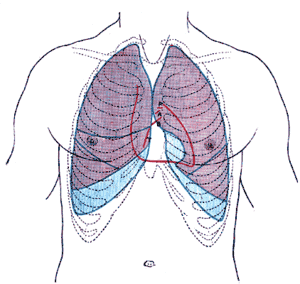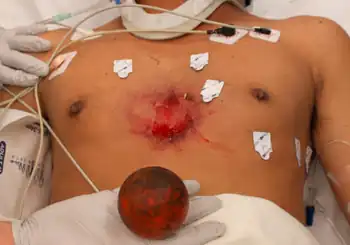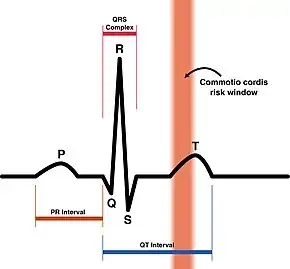Commotio cordis
| Commotio cordis | |
|---|---|
| Other names: Cardiac Arrest | |
 | |
| Human adult thorax, showing the outline of the heart in red. The sensitive zone for mechanical induction of heart rhythm disturbances lies between the second and the fourth ribs, to the left of the sternum. | |
| Specialty | Emergency medicine |
Commotio cordis is a rare disruption of heart rhythm that occurs as a result of a blow to the area directly over the heart (the precordial region) at a critical instant during the cycle of a heartbeat,[1] 97% fatal if not treated within three minutes.[2] This sudden rise in intracavitary pressure leads to disruption of normal heart electrical activity, followed instantly by ventricular fibrillation, complete disorganization of the heart's pumping function, and cardiac arrest. It is not caused by mechanical damage to the heart muscle or surrounding organs and is not the result of heart disease.
Its incidence in the United States is fewer than 20 cases per year, often occurring in boys participating in sports, most commonly in baseball when a ball strikes a player in the chest.
Commotio cordis can occur only upon impact within a narrow window of about 40 milliseconds in the cardiac electrical cycle, explaining why it is so rare.[1]
If cardiopulmonary resuscitation (CPR) combined with use of an on-site automated external defibrillator is employed within three minutes of the impact, survival from commotio cordis can be as high as 58 percent.[3] It is from the Latin, "agitation or disruption of the heart".
Signs and symptoms

Commotio cordis is due to blunt trauma to chest causing a irregular heart rhythm [4]
Due to ventricular fibrillation and resultant cessation of the cardiac output to vital organs, commotio cordis has a high fatality rate, indicated by two studies to be 72–75 percent, with survival decreasing substantially if effective resuscitation was not performed within three minutes of the impact event.[3][2]
Causes
Sports
Commotio cordis is a very rare event, but nonetheless it is often considered when an athlete presents with sudden cardiac death. Some of the sports which have a risk for this cause of trauma are baseball, American football, association football (soccer), ice hockey, polo, rugby football, cricket, softball, pelota, lacrosse, boxing, professional wrestling, hurling and martial arts (see Touch of Death). Children are especially vulnerable, possibly due to the mechanical properties of their thoracic skeleton.[1][5] From 1996 to spring 2007, the USA National Commotio Cordis Registry had 188 cases recorded, with about half occurring during organized sports.[6] Almost all (96%) of the victims were male, the mean age of the victims during that period was 14.7 years, and fewer than one in five survived the incident.[6]
Baseball is the most common sport in which commotio cordis occurs in regions where it is played, particularly among teenage boys who are batting or playing the positions of pitcher or catcher.[1] Commotio cordis may occur in other sports via impacts to the chest by elbows or heads.[1] It has also been reported outside of sports when there is sudden impact to the chest wall by hard objects or fists.[1]
Impact factors
In experimental animal models in pigs studying impacts by a hard ball to the chest wall, impacts that occurred directly over the center of the left ventricle, where there is no overlying lung tissue, were the most likely to cause ventricular fibrillation.[1] Impacts not over the heart did not cause ventricular fibrillation.[1] Ventricular fibrillation was more easily induced in smaller, leaner animals.[1]
The velocity of the impact by a hard object is a critical factor for the onset of commotio cordis: impacts at 40 miles per hour (64 kilometres per hour) were the most likely to cause ventricular fibrillation in an animal model.[1] At velocities of 20 miles per hour (32 km/h), ventricular fibrillation did not occur.
Impact energies of at least 50 joules (37 foot-pounds force) may cause cardiac arrest when applied at the right time and location of the precordium of an adult.[7] The 50-joule threshold, however, can be considerably lower when the victim's heart is under ischemic conditions, such as in coronary artery insufficiency.[7] Contusion of the heart, involving possible rupture of a heart chamber or damage to a heart valve as may occur in a violent vehicle accident, may be called contusio cordis (from Latin for "bruising of the heart"), but is unrelated to commotio cordis.[1]
Other situations
Commotio cordis may also occur in other situations, such as in children who are physically abused, cases of torture, and frontal collisions of motor vehicles (the impact of the steering wheel against the thorax, although this has decreased substantially with the use of safety belts and air bags). In one fatality, the impact to the chest was the result of an exploding whipped cream canister.[8]
In contrast, the precordial thump (hard blows given over the precordium with a closed fist to revert cardiac arrest) is a sanctioned procedure for emergency resuscitation by trained health professionals witnessing a monitored arrest when no equipment is at hand, endorsed by the latest guidelines of the International Liaison Committee on Resuscitation. It has been discussed controversially, as—in particular in severe hypoxia—it may cause the opposite effect (i.e., a worsening of rhythm—commotio cordis). In a normal adult, the energy range involved in the precordial thump is five to ten times below that associated with commotio cordis.[7]
Mechanism

The deviation of commotio cordis from the normal electrical rhythm of the heart is assessed scientifically in laboratory studies by analysis of the electrocardiograph (ECG) T wave (see ECG image).[1] Only chest impacts occurring on a narrow band of the ECG during the upslope of the T wave (40 milliseconds (ms) before the peak of the T wave to the instant of the actual peak) will cause the ventricular fibrillation of commotio cordis, with an increased probability occurring when an impact happens from 30 to 10 ms before the peak of the T wave.[1]
These factors influence the onset of commotio cordis:[1]
- Direction of impact over the precordium (precise area, angle of impact)
- Total applied energy (area of impact versus energy, i.e., the kinetic energy of the projectile )
- Impact occurring within a specific 10- to 30-ms portion of the cardiac cycle. This period occurs in the ascending phase of the T wave when the left ventricle is repolarizing, moving from systole to diastole (relaxation).
The small window of vulnerability in the cardiac electrical cycle explains why it is a rare event.[1] Considering that the total cardiac cycle has a duration of one second (for a base heart rate of 60 beats per minute), the probability of impact trauma within the window of vulnerability is 1–3 percent only.[1]
The cellular mechanisms of commotio cordis are not fully understood. However, it is widely recognized that it may be related to the mechanical impact, or stretch, on the myocardial tissue cell membranes. This impact is believed to activate the stretch-activated, pressure–sensitive proteins called ion channels.[1] Changes in ion channels lead to altered repolarization in the heart's electrical activity, which in some cases, if occurring right at the trailing edge of a previous electrical cycle, can induce ventricular fibrillation, also known as stretch-induced VF.[1][9][10] Since the trailing edge of the preceding electrical cycle travels over the ventricular surface, the critical window for mechanical induction of ventricular fibrillation varies locally across the ventricle.[9]
Diagnosis
Differential diagnosis
The DDx for Commotio cordis is as follows:[4]
- Hypertrophic cardiomyopathy
- Arrhythmogenic right ventricular dysplasia
- Long QT syndrome
- Wolf-Parkinson-White syndrome
- Dilated cardiomyopathy
- Aortic valve stenosis
Prevention
For some sports participation in which hard balls are used, such as baseball or lacrosse, softer, more pliable balls may reduce the impact trauma causing commotio cordis.[1] The shape of the impact object may be modified for some conditions, such as by using a flat object – which did not induce ventricular fibrillation upon impact in preliminary research – whereas spherical objects with smaller radii were more likely to induce ventricular fibrillation.[1] Safety baseballs having lower degrees of hardness, e.g., softer, pliable and elastic balls used for Tee-ball or more pliable baseballs for older age groups, may reduce the risk of commotio cordis.[1]
The risk of impact may be reduced by improved coaching techniques, such as teaching young batters to turn away from the ball to avoid errant pitches in baseball. Defensive players in lacrosse and hockey may be coached to avoid using their chest to block the ball or puck. Starting in 2017, high school lacrosse players are penalized, and play is stopped immediately if they enter their own goal crease with the apparent intent of blocking shots or acting as goalkeeper.[11]
Chest protectors and vests are designed to reduce trauma from blunt bodily injury, but many commercially available chest protectors do not offer protection from commotio cordis and may offer a false sense of security.[1] A 2010 study found that almost 20 percent of the victims in competitive football, baseball, lacrosse, and hockey were wearing protectors.[5] A 2017 study found that specially-designed chest protectors do reduce the risk of commotio cordis, but do not offer 100 percent protection.[12]
Treatment

Automated external defibrillators (AED) and prompt CPR helped to increase the survival rate in to 58 percent.[3] CPR and defibrillation must be started urgently (within three minutes) to avoid death of the person impacted.[3] To assure life-saving procedures and equipment are in place at events where impact injuries are possible, clinical recommendations state that "communities and school districts reexamine the need for accessible automatic defibrillators and CPR-trained coaches at organized sporting events for children."[13]
Higher survival rates correlated with immediate resuscitation by using CPR and an on-site automated external defibrillator—the survival rate was forty percent if resuscitation was performed within three minutes of the impact injury, contrasted with only five percent survival if resuscitation was delayed to more than three minutes after the impact.[3]
Epidemiology
There are only 10–20 cases annually in the United States.[1] These cases occur mostly in boys and young men (mean age 15), usually during sports participation.[1] It occurs most frequently in baseball when the hard ball strikes an unprotected chest, although there have been cases of commotio cordis in players using a chest protector.[1] It is usually caused by a projectile, but can also be caused by a blow from another player's elbow or other body part. Being less developed, the thorax of an adolescent is likely more prone to this injury than a mature adult.[1]
Over a period of assessment from 2006–2012, the survival rate was 58 percent, which was an improvement over the years 1993–2006 when only 34 percent of victims survived.[3][14] This increase is likely due to prompt CPR, access to defibrillation, and higher public awareness of this phenomenon.[1][3]In a United States timeline analysis, survival was only ten percent over the years 1970–1993, while during 1994–2012, survival improved to 34 percent.[3] A 2009 paper reported that survival drops to 3% when resuscitation is delayed beyond 3 minutes.[2]
Society and culture
Several people have been charged and convicted for the deaths of victims of commotio cordis, even when the blows rendered were never given with an intent to kill.[15] In 1992, Italian hockey player Miran Schrott died after a blow to his chest from the stick of Italian-Canadian player Jimmy Boni. Boni was charged with culpable homicide, and eventually pleaded guilty to manslaughter, paying a $1,300 fine and $175,000 restitution to Schrott's family.[16]
See also
- Commotio thoracis
- Pulmonary contusion
- R-on-T phenomenon
- Touch of Death
References
- 1 2 3 4 5 6 7 8 9 10 11 12 13 14 15 16 17 18 19 20 21 22 23 24 25 26 27 Link, Mark S. (2012-04-01). "Commotio Cordis: Ventricular Fibrillation Triggered by Chest Impact–Induced Abnormalities in Repolarization". Circulation: Arrhythmia and Electrophysiology. 5 (2): 425–432. doi:10.1161/CIRCEP.111.962712. PMID 22511659.
- 1 2 3 >Palacio, Luis E.; Link, Mark S. (March 2009). "Commotio Cordis". Sports Health: A Multidisciplinary Approach. 1 (2): 174–179. doi:10.1177/1941738108330972. ISSN 1941-7381. PMC 3445066. PMID 23015869.
- 1 2 3 4 5 6 7 8 Maron, Barry J.; Haas, Tammy S.; Ahluwalia, Aneesha; Garberich, Ross F.; Estes, N. A. Mark; Link, Mark S. (February 2013). "Increasing survival rate from commotio cordis". Heart Rhythm. 10 (2): 219–223. doi:10.1016/j.hrthm.2012.10.034. ISSN 1556-3871. PMID 23107651.
- 1 2 Palacio, Luis E.; Link, Mark S. (2009). "Commotio Cordis". Sports Health. 1 (2): 174–179. doi:10.1177/1941738108330972. ISSN 1941-7381. Archived from the original on 7 March 2023. Retrieved 31 March 2023.
- 1 2 Maron BJ, Estes NA (March 2010). "Commotio cordis". The New England Journal of Medicine. 362 (10): 917–927. doi:10.1056/NEJMra0910111. PMID 20220186.
- 1 2 "Position Statement on Commotio Cordis". US Lacrosse. January 2008. Archived from the original on 23 February 2017. Retrieved 22 February 2017.
- 1 2 3 Kohl P, Sachs F & Franz M (eds): Cardiac Mechano-Electric Feedback and Arrhythmias: from Pipette to Patient. Elsevier (Saunders), Philadelphia 2005.
- ↑ Barnes, Zahra. "Fitness Blogger Rebecca Burger Died After a Whipped Cream Dispenser Exploded". SELF. Archived from the original on 2017-07-27. Retrieved 2017-07-14.
- 1 2 Quinn, T. Alexander; Jin, Honghua; Lee, Peter; Kohl, Peter (2017-08-09). "Mechanically Induced Ectopy via Stretch-Activated Cation-Nonselective Channels Is Caused by Local Tissue Deformation and Results in Ventricular Fibrillation if Triggered on the Repolarization Wave Edge (Commotio Cordis)". Circulation: Arrhythmia and Electrophysiology. 10 (8): e004777. doi:10.1161/CIRCEP.116.004777. ISSN 1941-3149. PMC 5555388. PMID 28794084.
- ↑ Quinn, T. Alexander; Kohl, Peter (2021-01-01). "Cardiac Mechano-Electric Coupling: Acute Effects of Mechanical Stimulation on Heart Rate and Rhythm". Physiological Reviews. 101 (1): 37–92. doi:10.1152/physrev.00036.2019. ISSN 0031-9333. S2CID 218554597.
- ↑ Rule 4.18.4, 2018 Boys' Lacrosse Rule Book. Indianapolis, Indiana: National Federation of State High School Associations. 2018. p. 47.
- ↑ Kumar, Kartik; Mandleywala, Swati N.; Gannon, Michael P.; et al. (2017). "Development of a Chest Wall Protector Effective in Preventing Sudden Cardiac Death by Chest Wall Impact (Commotio Cordis)". Clinical Journal of Sport Medicine. 27 (1): 26–30. doi:10.1097/JSM.0000000000000297. PMC 5181132. PMID 27014942.
- ↑ Salib EA, Cyran SE, Cilley RE, Maron BJ, Thomas NJ (December 2005). "Efficacy of bystander cardiopulmonary resuscitation and out-of-hospital automated external defibrillation as life-saving therapy in commotio cordis". The Journal of Pediatrics. 147 (6): 863–866. doi:10.1016/j.jpeds.2005.07.041. PMID 16356450.
- ↑ Abrunzo TJ (November 1991). "Commotio cordis. The single, most common cause of traumatic death in youth baseball". American Journal of Diseases of Children. 145 (11): 1279–1282. doi:10.1001/archpedi.1991.02160110071023. PMID 1951221. S2CID 31217442.
- ↑ Maron BJ, Mitten MJ, Greene Burnett C (January 2002). "Criminal consequences of commotio cordis". The American Journal of Cardiology. 89 (2): 210–213. doi:10.1016/S0002-9149(01)02202-0. PMID 11792344.
- ↑ Maki, Allan (28 September 2007). "Darcy Robinson's death brings shock". The Globe and Mail. Archived from the original on 4 March 2016. Retrieved 29 February 2016.
Further reading
- Kohl P, Nesbitt AD, Cooper PJ, Lei M (May 2001). "Sudden cardiac death by Commotio cordis: role of mechano-electric feedback". Cardiovascular Research. 50 (2): 280–289. doi:10.1016/S0008-6363(01)00194-8. PMID 11334832.
- Geddes LA, Roeder RA (January 2005). "Evolution of our knowledge of sudden death due to commotio cordis". The American Journal of Emergency Medicine. 23 (1): 67–75. doi:10.1016/j.ajem.2003.12.023. PMID 15672341.
External links
| Classification | |
|---|---|
| External resources |
- Yabek, S.M. Commotio cordis Archived 2023-02-25 at the Wayback Machine. eMedicine, September 2005.
- National Commotio Cordis Registry Archived 2023-03-23 at the Wayback Machine (US)